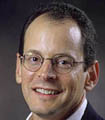
Jonathan Rauch
With a hum instead of a roar, the fuel-cell is here
http://www.NewsAndOpinion.com | Honda Motor's Tochigi R&D center is about an hour from Tokyo by bullet train, north across the Kanto Plain. Immediately visible from the gatehouse is a crash-test center, nearly the size of a sports arena. Down the road, on the ground floor of an office building, 200 or more workers sit at desks in a single immense and undivided room, 100 percent cubicle-free. Most of the desks are equipped with laptop computers. Everyone wears the regulation two-piece Honda uniform: white waist-length jacket and white pants. Meeting rooms are stocked with spare uniforms, just in case. Clearly, this is not America.
In one of those meeting rooms last month, I talked with Yuji Kawaguchi, a senior engineer with Honda's fuel-cell program. He used to work on electric cars, but that concept fizzled. So did plans for methane-burning cars. For decades, people have predicted the demise of the fire-bellied, filth-belching internal combustion engine -- and for decades, the internal combustion engine has made fools of them all. But this time might be different.
Kawaguchi, an unassuming man who speaks passable English, declined to be specific about the size of his team, but I gathered that Honda has 100 or more people at work on fuel-cell vehicles. Most days, Kawaguchi works from 9 a.m. until anywhere between 7 and 10 at night. The job entails a certain amount of stress, because the board of directors keeps a close eye on the fuel-cell program, believing that it might hold the key to Honda's future. "My personal target," Kawaguchi says, "is to make a fuel-cell production vehicle" before retiring at age 60. That would be within the next 12 years. He just might do it.
Last month, Honda and Toyota Motor announced the commercial availability of passenger cars powered by fuel cells. The principle of the fuel cell was discovered as long ago as 1839, but practicality has come only recently. The problem has always been to shrink bulky, heavy fuel cells to a size that leaves room for passengers and cargo. As of December, the challenge is met. Honda and Toyota have leased a handful of fuel-cell-powered cars to government agencies in Tokyo and Los Angeles, where employees are now driving them around.
It would be a mistake to make too much of this. The Honda and Toyota cars are very, very expensive to manufacture. How expensive? "I can only say the expense is enormous," said Shinichi Yamaguchi, of Toyota's environmental-affairs division, during an interpreted interview in Japan's Toyota City, near Nagoya. Each company plans to produce only one or so of these precious jalopies a month for the next year or two. Still, the problem of stuffing big fuel cells into little cars is now officially solved.
That leaves other problems. Fuel cells run on hydrogen gas, and fueling stations, apart from a few experimental ones, don't exist. (By the end of 2003, Tokyo will have, count 'em, 10 such stations.) The engines are hard to start in cold weather, and they have trouble providing surge power for acceleration at highway speeds.
Nonetheless, most or all of those problems can be solved with existing technologies, and the cars are expensive mainly because they are still handmade. Standardization and mass production will reduce costs by orders of magnitude. Kawaguchi figures on general availability for specialized fleets in five to 10 years.
Meanwhile, the core technology -- the fuel cell itself -- continues to develop quickly. Honda's 1999 version filled about half the car. Since then, engineers have brought the weight down more than 200 pounds, to about 650, and have cut the size in half. In the next version, Kawaguchi thinks, they may be able to halve the size again.
This is good news at a time when the world could use some. Oil is dirty to extract and even dirtier to burn. Two-thirds of it is used in transportation, mostly in cars and trucks. The electrical grid can be powered by coal or nuclear plants or water, and in principle by wind or sun; but as of now, cars run only on gasoline. Petroleum's stranglehold on the automobile is what makes Iraq and Saudi Arabia so much more important than anyone likes.
Simply reducing gasoline consumption on the margins is good for the environment, but it won't solve the geopolitical problem. Oil imports from the Middle East are the last to be squeezed out when demand falls, because Persian Gulf oil is the world's cheapest to produce. As President Bush said in December, "We must have an energy policy that diversifies away from dependency" on foreign oil suppliers who "don't like America."
Fuel cells don't burn gasoline. They don't burn anything. Turn on a fuel-cell car and there's no ignition, no roar, no shudder, no plume of smoke -- just a quiet hum. The fuel cell catalyzes hydrogen and oxygen to produce energy with about 45 percent efficiency. That's more than twice the efficiency of an internal combustion engine, which delivers less than 20 percent of the energy in a tank of gas to the wheels of the car. In a fuel-cell car, nothing comes out of the tailpipe but a trickle of water.
Hydrogen can be derived from fossil fuels (natural gas is the most efficient), from electrolyzed water, from methanol, even, if a new technique pans out, from corn starch and sugar beets. The most energy-hungry of those processes is still cleaner and more efficient than extracting, refining, and burning gasoline. Moreover, it would not be hard to produce hydrogen at home. Why build another 175,000 filling stations? You could fuel your car in the garage and save the H-station for highway trips.
So everyone, everywhere, is betting on fuel cells. At least eight companies, according to Dan Baum in the August issue of Wired magazine, have built drivable prototypes. Nissan and DaimlerChrysler are promising passenger cars this year; Ford, in 2004. In 2002, the U.S. government scrapped its Clinton-era Partnership for a New Generation of Vehicles, which aimed at tripling gasoline-engine efficiency, in favor of a new "FreedomCAR" (for Cooperative Automotive Research) program that aims to move from gasoline to hydrogen. Europe and Japan -- and California and Michigan -- are mounting fuel-cell efforts of their own.
Most startling is General Motors' approach. The company says it has about 600 people working on fuel cells in three American facilities, plus another in Germany; it intends, GM says, to "commercialize fuel-cell-powered vehicles as a sustainable business by the end of the decade." It is determined, however, to redesign not just the power train but the entire car. A visionary concept car called the AUTOnomy, unveiled in 2002, slides the fuel-cell engine and all drive components into a modular, 8-inch-thick "skateboard" chassis, to which consumers could bolt any of a variety of body styles. Because the car would be operated electronically rather than mechanically, the driver could sit wherever she wanted inside the car. Each wheel could have its own electric motor and steering, so the car could pivot and drive sideways.
What isn't clear is whether the AUTOnomy will ever fly as a business proposition. GM won't even decide whether to produce it for several years. The Japanese, always more practical than visionary, are first and fastest with actual fuel cells in actual cars. Honda, according to Kawaguchi, aims for customer availability ASAP. The message from Toyota is much the same: Push the technology out the door and onto the streets.
Which approach is better, incremental or radical? Both. They complement each other. (In fact, GM has also designed a traditionally configured fuel-cell car, called the HydroGen3, which it plans to begin testing on FedEx runs in Tokyo this June.)
Notice, in this connection, what you aren't hearing: barks of alarm about Japan's "winning" a "fuel-cell race." That's not just because Americans are otherwise occupied. The big Japanese automakers now sell more cars in America than in Japan, and they build a lot of them here, too, in high-tech plants where Japanese faces are rarely seen. Chrysler is now the trailing half of a Euro-American conglomerate. GM is busy investing in China. The automobile industry is increasingly international.
That is a fortunate thing. Breaking the hundred-year monopoly of the internal combustion engine is as vast a project as capitalism has ever undertaken. Given the immensity of the risks involved and the uncountable billions of dollars of capital investment required, the project is nothing short of planetary in scale. Simultaneous competition and collaboration across national borders -- also known as globalization -- provides the only hope of success.
These days, therefore, Japan looks less like a rival than
a resource. If you care about America's long-term security,
say thank-you to Yuji Kawaguchi. And if you care about stopping
global warming and preventing conservative presidents from
going to war for oil, be grateful for globalization.
JWR contributor Jonathan Rauch is a senior writer and columnist for National Journal. Comment by clicking here.
12/12/02: Forcing Americans to put their money where their mouths are
09/30/02: Once again, a President Bush saves the U.N. from its friends
05/08/02: The world on a screen
03/12/02: To make peace, should Israel first take back land?
02/22/02: A NYTimes columnist defends his paper's principles
02/14/02: Bush's gas tax
01/31/02: Don't Fear Bin Ladenism's Strength. Fear Its Weakness
01/17/02: Next Stop In The War Against Terrorism: Damascus
01/03/02: Countering the smallpox threat
12/06/01: Discovered! The Mullahs' minutes, or: How to end Western society
11/05/01: Why Bush (Senior) Didn't Blow It in the Gulf War
10/01/01: Charter Schools: A New Hope For America's Latinos
09/20/01: What leaders said about the attack--and what they meant
08/22/01: They Secretly Cloned Mozart!

